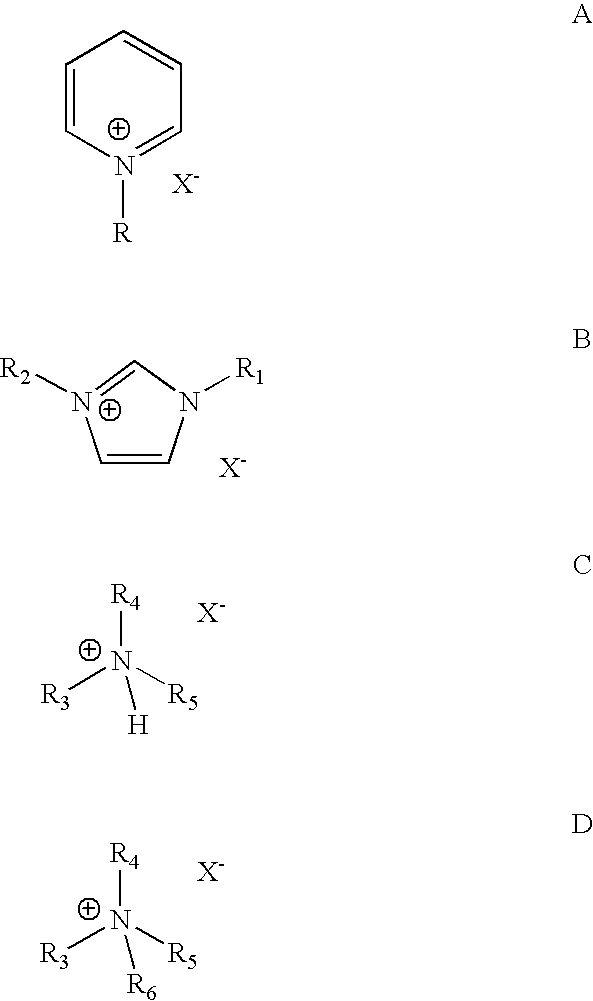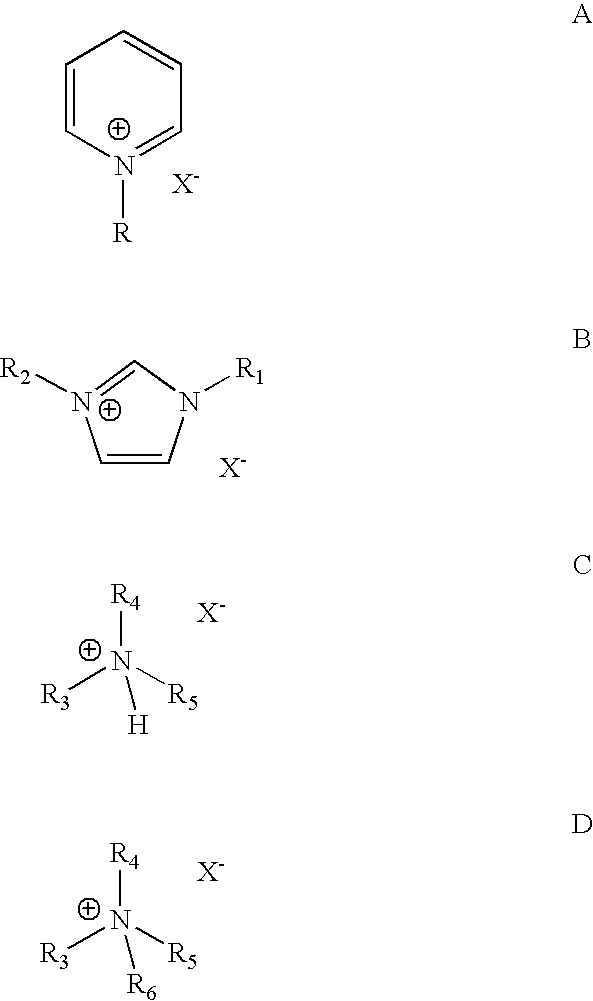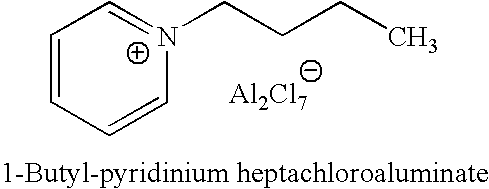Alkylation process using an alkyl halide promoted ionic liquid catalyst
a technology of alkyl halide and ionic liquid catalyst, which is applied in the direction of hydrocarbon preparation catalyst, organic chemistry, chemistry apparatus and processes, etc., can solve the problems of no viable replacement for the current process in commercial refineries, and the need for safer and environmentally friendly catalyst systems has become an issue for the industries involved
- Summary
- Abstract
- Description
- Claims
- Application Information
AI Technical Summary
Benefits of technology
Problems solved by technology
Method used
Image
Examples
example 1
Preparation of Fresh 1-Butylpyridinium Chloroaluminate Ionic Liquid Catalyst A (Fresh IL A)
[0036]1-butyl-pyridinium chloroaluminate is a room temperature ionic liquid prepared by mixing neat 1-butyl-pyridinium chloride (a solid) with neat solid aluminum trichloride in an inert atmosphere. The syntheses of butylpyridinium chloride and the corresponding 1-butyl-pyridinium chloroaluminate are described below.
[0037]In a 2-L Teflon-lined autoclave, 400 gm (5.05 mol.) anhydrous pyridine (99.9% pure purchased from Aldrich) were mixed with 650 gm (7 mol.) 1-chlorobutane (99.5% pure purchased from Aldrich). The autoclave was sealed and the neat mixture was allowed to stir at 125° C. under autogenic pressure over night. After cooling off the autoclave and venting it, the reaction mix was diluted and dissolved in chloroform and transferred to a three liter round bottom flask. Concentration of the reaction mixture at reduced pressure on a rotary evaporator (in a hot water bath) to remove excess...
example 2
Alkylation of isoPentane with Ethylene Without the Presence of a Promoter
[0040]A 300 cc autoclave was charged with 40 gm of ionic liquid catalyst, 100 gm anhydrous isopentane and 10 gm ethylene. The reaction was then stirred at ˜1200 rpm and heated to 50° C. at autogenic pressures. The starting pressure was 288 psi. The reaction was allowed to run until the pressure dropped down into the single digits range (5 psi in this case after 28 minutes reaction time). In the case of slow going reaction, the reaction was allowed to run for 1 hr long. At the end of the reaction, the reactor was vented out and a gas sample was checked by GC for ethylene concentration. The liquid reaction mixture was allowed to settle into 2 phases. The organic phase was decanted and analyzed for product distribution by GC analysis. The reaction results are shown in Table 1.
example 3
Alkylation of isoPentane with Ethylene in the Presence of HCl as Co-catalyst
[0041]Table 1 below shows the results of the alkylation of ethylene with isopentane in the presence of ethyl chloride and in the presence of iospentyl chloride. The alkylation of isopentane with ethylene was done according to the following procedure.
[0042]A 300 cc autoclave was charged with 40 gm of ionic liquid catalyst, 100 gm anhydrous isopentane, 10 gm ethylene, and 0.35 gm of anhydrous HCl. The reaction was then stirred at ˜1200 rpm and heated to 50° C. at autogenic pressures. The starting pressure was 320 psi. The reaction was allowed to run until the pressure dropped down into the single digits range (9 psi in this case after 4 minutes reaction time). In the case of slow going reaction, the reaction was allowed to run for 1 hr long. At the end of the reaction, the reactor was vented out and a gas sample was checked by GC for ethylene concentration. The liquid reaction mixture was allowed to settle int...
PUM
| Property | Measurement | Unit |
|---|---|---|
| molar ratio | aaaaa | aaaaa |
| molar ratio | aaaaa | aaaaa |
| pressure | aaaaa | aaaaa |
Abstract
Description
Claims
Application Information
 Login to View More
Login to View More - R&D
- Intellectual Property
- Life Sciences
- Materials
- Tech Scout
- Unparalleled Data Quality
- Higher Quality Content
- 60% Fewer Hallucinations
Browse by: Latest US Patents, China's latest patents, Technical Efficacy Thesaurus, Application Domain, Technology Topic, Popular Technical Reports.
© 2025 PatSnap. All rights reserved.Legal|Privacy policy|Modern Slavery Act Transparency Statement|Sitemap|About US| Contact US: help@patsnap.com



